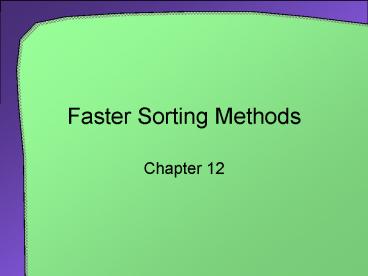Faster Sorting Methods PowerPoint PPT Presentation
1 / 23
Title: Faster Sorting Methods
1
Faster Sorting Methods
- Chapter 12
2
Chapter Contents
- Merge Sort
- Merging Arrays
- Recursive Merge Sort
- The Efficiency of Merge Sort
- Iterative Merge Sort
- Merge Sort in the Java Class Library
- Quick Sort
- The Efficiency of Quick Sort
- Creating the Partition
- Java Code for Quick Sort
- Quick Sort in the Java Class Library
- Radix Sort
- Pseudocode for Radix Sort
- Comparing the Algorithms
3
Merge Sort
- Divide an array into halves
- Sort the two halves
- Merge them into one sorted array
- Referred to as a divide and conquer algorithm
- This is often part of a recursive algorithm
- However recursion is not a requirement
4
Merge Sort
Fig. 12-1 Merging two sorted arrays into one
sorted array.
5
Merge Sort
Fig. 12-2 The major steps in a merge sort.
6
Merge Sort
Algorithm mergeSort(a, first, last) // Sorts the
array elements afirst through alast
recursively. if (first lt last) mid (first
last)/2 mergeSort(a, first, mid) mergeSort(a,
mid1, last) Merge the sorted halves
afirst..mid and amid1..last
7
Merge Sort
Fig. 12-3 The effect of the recursive calls and
the merges during a merge sort.
8
Merge Sort
- Efficiency of the merge sort
- Merge sort is O(n log n) in all cases
- It's need for a temporary array is a disadvantage
- Merge sort in the Java Class Library
- The class Arrays has sort routines that uses the
merge sort for arrays of objects
public static void sort(Object a) public
static void sort(Object a, int first, int last)
9
Quick Sort
- Divides the array into two pieces
- Not necessarily halves of the array
- An element of the array is selected as the pivot
- Elements are rearranged so that
- The pivot is in its final position in sorted
array - Elements in positions before pivot are less than
the pivot - Elements after the pivot are greater than the
pivot
10
Quick Sort
Algorithm quickSort(a, first, last) // Sorts the
array elements afirst through alast
recursively. if (first lt last) Choose a
pivot Partition the array about the
pivot pivotIndex index of pivot quickSort(a,
first, pivotIndex-1) // sort Smaller quickSort(a,
pivotIndex1, last) // sort Larger
11
Quick Sort
Fig. 12-4 A partition of an array during a quick
sort.
12
Quick Sort
- Quick sort is O(n log n) in the average case
- O(n2) in the worst case
- Worst case can be avoided by careful choice of
the pivot
13
Quick Sort
Fig. 12-5 A partition strategy for quick sort
continued?
14
Quick Sort
Fig. 12-5 (ctd.) A partition strategy for quick
sort.
15
Quick Sort
Fig. 12-6 Median-of-three pivot selection (a)
the original array (b) the array with its first,
middle, and last elements sorted
16
Quick Sort
Fig. 12-7 (a) The array with its first, middle,
and last elements sorted (b) the array after
positioning the pivot and just before
partitioning.
17
Quick Sort
- Quick sort rearranges the elements in an array
during partitioning process - After each step in the process
- One element (the pivot) is placed in its correct
sorted position - The elements in each of the two sub arrays
- Remain in their respective subarrays
- The class Arrays in the Java Class Library uses
quick sort for arrays of primitive types
18
Radix Sort
- Does not compare objects
- Treats array elements as if they were strings of
the same length - Groups elements by a specified digit or character
of the string - Elements placed into "buckets" which match the
digit (character) - Originated with card sorters when computers used
80 column punched cards
19
Radix Sort
Fig. 12-8 (a) Original array and buckets after
first distribution (b) reordered array and
buckets after second distribution continued ?
20
Radix Sort
Fig. 12-8 (c) reordered array and buckets after
third distribution (d) sorted array
21
Radix Sort
- Pseudo code
Algorithm radixSort(a, first, last, maxDigits)//
Sorts the array of positive decimal integers
afirst..last into ascending order// maxDigits
is the number of digits in the longest
integer. for (i 1 to maxDigits) Clear
bucket0, bucket1, . . . , bucket9 for
(index first to last) digit ith digit from
the right of aindex Place aindex at end of
bucketdigit Place contents of bucket0,
bucket1, . . . , bucket9 into the array a
Radix sort is O(n) but can only be used for
certain kinds of data
22
Comparing the Algorithms
- Fig. 12-9 The time efficiency of various
algorithms in Big Oh notation
23
Comparing the Algorithms
Fig. 12-10 A comparison of growth-rate functions
as n increases.

